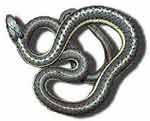
Thamnophis
elegans
(Western Terrestrial
Garter Snake)

| Key Characteristics |
| Three light (yellow to cream) stripes |
| Black spots often break the margin of dorsal stripe |
| Ground color usually a olive or greenish-gray |
| Usually eight labial scales, with 6th and 7th enlarged |
| Round pupils |
General
Description:
Different garter
snake species can superficially resemble each other. However, in Idaho,
determining which species of garter snake you find is easier than in other parts
of the country because we only have 2 species. A standard method
used to distinguish between garter snake species is observing scale patterns.
Western Terrestrial Garter Snakes generally have 10
lower labial scales, and 8 upper labial scales. The 6th and 7th upper
labial
scales![]() are usually enlarged (higher than they are wide), due to the presence of glands
in the upper jaw. The dorsal scales are keeled and their pupils are round.
Western Terrestrial Garter Snakes have a olive to grayish-green ground color
dorsally. The ground color is marked by a light colored (yellow to cream)
dorsal stripe that extends from the base of the head, along most or all of the
body. Generally, there is also a single lateral stripe on each side that
is similar in color to the dorsal stripe. The lateral stripes appear to
originate on the labial scales, which are similarly colored, and also extend
along most or all of the body. In
addition to the stripes, there is usually a series of dark spots that are
associated with the stripes and they may break the stripe margin. Western
Terrestrial Garter Snakes have a gray or beige ventral color that may have dark
markings concentrated down the mid-ventral line (Nussbaum et al. 1983).
As though garter snake coloration wasn't variable enough, occasionally melanistic
(all black) snakes are encountered (Mark Gerber pers. com. 1996, Charles R.
Peterson pers. com. 1998).
are usually enlarged (higher than they are wide), due to the presence of glands
in the upper jaw. The dorsal scales are keeled and their pupils are round.
Western Terrestrial Garter Snakes have a olive to grayish-green ground color
dorsally. The ground color is marked by a light colored (yellow to cream)
dorsal stripe that extends from the base of the head, along most or all of the
body. Generally, there is also a single lateral stripe on each side that
is similar in color to the dorsal stripe. The lateral stripes appear to
originate on the labial scales, which are similarly colored, and also extend
along most or all of the body. In
addition to the stripes, there is usually a series of dark spots that are
associated with the stripes and they may break the stripe margin. Western
Terrestrial Garter Snakes have a gray or beige ventral color that may have dark
markings concentrated down the mid-ventral line (Nussbaum et al. 1983).
As though garter snake coloration wasn't variable enough, occasionally melanistic
(all black) snakes are encountered (Mark Gerber pers. com. 1996, Charles R.
Peterson pers. com. 1998).
Western Terrestrial Garter Snakes are medium-sized snakes that can reach up to 107 cm (43 in.) (Storm and Leonard 1995).
Western Terrestrial Garter Snakes generally breed in the spring but fall mating has been reported (Storm and Leonard 1995). Like all garter snakes, they give live-birth rather than laying eggs. Usually 4 to 19 young are born between July and September (Nussbaum et al. 1983).
Habitat:
Western Terrestrial
Garter Snakes are often found near
water, but as their name implies, they can be found away
from any nearby water source. These snakes can be found in habitats
ranging from desert riparian areas, to mountain lakes and meadows.
Idaho
Distribution:
In Idaho, Western Terrestrial
Garter Snakes can be found statewide.
Diet:
Feeds on slugs,
worms, snails, leeches, tadpoles, frogs, fishes, mice, and occasionally, small
birds and lizards. Also eats insects and carrion.
Ecology:
Chiefly terrestrial,
but may also be aquatic depending on area. Hibernates![]() /aestivates
/aestivates![]() ,
at times with other species; duration of inactive period varies with local climate.
Species' saliva is reportedly mildly poisonous. Preyed upon by birds.
,
at times with other species; duration of inactive period varies with local climate.
Species' saliva is reportedly mildly poisonous. Preyed upon by birds.
Reproduction:
Mates in the
spring; 4-19 live young are born from July to September, depending on range.
Conservation:
|
Status: |
Unprotected nongame species |
|
Global Rank: |
|
|
State Rank: |
S5 |